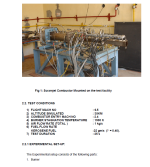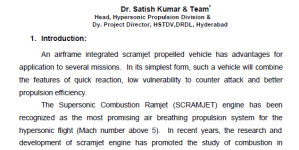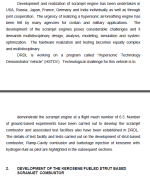The Premise
On 27 Jan 2023, the Abdul Kalam Island off the Odisha Coast was abuzz with hectic activity. At the countdown 5,4,3,2,1, now….. the Agni I Missile lifted off carrying the Hypersonic Technology Demonstration Vehicle (HSTDV) for the third time
[1]. The earlier two tests took place on 07 Sep 2020
[2] and 12 Jun 2019
[3] respectively.
While the naysayers would trash all the three successive tests as a hat-trick of failures/ negligible successes, this brief work argues that this trio of tests marks a steady climb from strength-to-strength on the uphill hypersonic journey; albeit in the ‘falling and getting up mode’ and a long way to go uphill still left.
Hypersonic – the Rise to Fame
‘Hypersonic’ has risen to fame in the past decade or so. It is trendy to crown the hypersonic capability with many an accoutrements – disruptive technology/game-changer, unstoppable and more.
Here is a de-cluttered version of why ‘hypersonic’ is splashing so much water?
[4]
- A hypersonic body (missile/glide vehicle) is a projectile that can travel at speeds that are five times (or more) than the speed of soundwhich is 0.343km/secand is called Mach 1. At this scale, Mach 5 will correspond to 1.715 Km/sec or 6174 km/h.
- Hypersonic weapons remain within the atmosphere (below 100 km) and utilise the atmospheric oxygen in combustion of their fuel.
- Such weapons currently exist in two categories, namely the Hypersonic Cruise missile (HCM) and Hypersonic glide Vehicle (HGV). Some salient points about these are presented:-
- An HCM is a typical cruise missile that is guided, remains low and is capable of striking terrestrial targets with high precision. The difference between a normal cruise missile and an HCM is, that the latter is ‘all-the-way powered’ missile. It’s SCRAMJET (supersonic combustion RAMJET) engine is capable of sustaining combustion of fuel and oxygen at supersonic speeds thus propelling the HCM at such tremendous speeds that are in the region of Mach 5-20.
- A HGV is propelled to a very high speed using a booster rocket. In this process, a stage is reached when the shock waves originating from the flight start to act as lifting surfaces. When this happens, the lift-to-drag ratio goes very high, the HGV separates from the booster and propels to the target at supersonic speeds ( this is called the wave-rider phenomenon).
- HCMs and HGVs are unstoppable by any conventional air defence and anti-missile system simply because they beat the minimum time required by a conventional system to accomplish the cycle of detection-interception and kill.
- Besides being unstoppable through conventional arsenal, hypersonic weapons have other unique strengths. These are briefly stated:-
- ‘Speed is the new stealth’ has been explained. The sheer speed makes such weapons too-fast to be detected.
- This further gives such weapon the capability to keep under their potential threat-print, large swaths of areas in the defender’s domain (forcing him to deploy resources on each of the vulnerabilities therein).
- Warheads carried at such tremendous speeds have greatly enhanced kinetic-kill effect due to the sheer momentum possessed by the warhead. According to one estimate, a warhead hurled at Mach 5 is likely to be 36 times more powerful as compared to a warhead striking at a normal speed.
What Threatens the Hypersonic Domain?
When US Carrier Strike Group Nimitz commenced operations in the South China Sea
[5] with effect from 12 Jan 2023 and later on 29 Jan 2023, Gen Mike Minihan, the head of US air Mobility Command expressed his view of a probable US-China conflict in 2025
[6], China showed her response in several ways (not covered), one of these is its claim of its Hypersonic anti-ship missile YJ 21 (Eagle Strike 21) which at Mach 10 (12348km/h) has the capability of penetrating directly through the deck of the aircraft carrier and eliminating it
[7]. Such is the claimed power of hypersonic weapons.
China possesses both the HCM and the HGV capability. Some points related to the Chinese hypersonic journey (threat) are briefly stated:-
[8]
- Chinese hypersonic development (own/stolen) is believed to have commenced way back but started to get noticed around 2015-17.
- In May 2018, Chinese tested an HGV on-board the boost vehicle DF 17. The projectile reportedly flew for 1400km and hit its target in the Xinjiang province within meters.
- In the same year in Aug, there was a report of a test flight of an HCM named Starry Sky -2 or Xinkong-2. The missile did 5.5-6 Mach, flew for 10 mins and achieved an altitude of 32 km.
- Later in Sep 2018, the open source reported a test run of three wide speed ranges scaled down hypersonic aircrafts (DF 18 1S, 2S and 3S) capable of prosecuting a precision strike with conventional, as well as, nuclear weapons.
- In Jul Aug 2021, the Chinese HGV on board the booster Long March, actually went over the South Pole achieving over Mach 5 (aim - ducking US missile defences poised North NE?).
- Something unprecedented happened in this test. Towards the end of the flight, the HGV launched another air-to-air-missile that flew for short time and plunged into the ocean (experts opined that it could be a satellite killer).
What does all the above mean?
- China is moving up swiftly along both the verticals of hypersonic capability.
- It is the sense of the author that on its cross-wires of global competition and deterrence is more US than India.
- The threat along with is associated command and control system is likely to be ‘battle deployable’ in a matter of few years.
The Indian Journey
With the hypersonic put in the perspective and threat lines broadly defined, the stage is set to explore the Indian story. Salient milestones in this journey are presented:-
- The Indian hypersonic journey started sometime in 2004. It was the year when the DRDO started R&D to realise a conceptual hypersonic air frame.
- In 2008, Dr V K Saraswat, the then DG DRDO hinted at the possible dual use of Hypersonic technology both as an HCM, as well as, a low cost satellite launch vehicle.
- The years 2011-2017 were largely spent in refining the hypersonic airframe design, building thermal protection techniques accomplishing integration strategies and more.
- During this period, two wind tunnels were put to use; one ex Israel and other provided by National Aeronautical Laboratory (NAL).
- It was around 2019 that our hypersonic capability achieved a test flight maturity.
The Hypersonic Test Runs
First Test
The first test of the Hypersonic Technology Demonstration Vehicle (HSTDV) took place on 12 Jun 2019.
[9]These are some factual details about the test:-
- The HSTDV was a 5.6 m aerodynamic body designed and developed by DRDO.
- It was boosted by Agni 1 solid-fuelled medium range ballistic missile, range 700km
[10]).
- The HSTDV achieved a speed of 6.5 Mach and an altitude of 30 km. It was in flight for nearly 20 secs.
Second Test[11]
The second test took place on 07 Sep 2020. The HSTDV achieved a speed of Mach 6 and flew for about 20 secs.
Third Test[12]
This test took place on 27 Jan 2023. The test target was to achieve a controlled and sustained powered flight of 600 secs achieving a range of 1500 km with a warhead carriage capability of 300-400 kg. Though specific figures as to the achievement or otherwise of the test targets has not been reported by the DRDO in the open source, the flight test has been claimed a success by the official Govt media.
Analysis
The DRDO in various reports after the tests (1-3) have claimed the following successes:-
- Maturity of design for an aerodynamic configuration capable of hypersonic manoeuvre.
- Thermo-structural maturity of HSTDV to withstand high temperatures.
- Proving of boost technologies to achieve speeds so as to set up the wave-rider phenomenon.
- Successful testing of scramjet propulsion technology for initiation of ignition and sustained combustion at hypersonic air flows using atmospheric oxygen
- Proving of the separation mechanism of the HGV from the booster and its powered hypersonic flight thereafter.
What the naysayers say:-
The naysayers (for many reasons – not covered) have dwarfed the tests by asserting the following:-
- The tests did not succeed the way it has been projected.
- In the first test, the ballistic carrier could not achieve its target; the booster went into an uncontrolled mode and did not achieve the required altitude.
- The HSTDV has not yet achieved its slated target of a sustained powered flight.
Author’s View
It is the sense of the author that the truth lies somewhere in the middle of the two versions; one of the DRDO/MoD and other of the naysayers. Following points are stated:-
- The live streaming videos of all the three launches do exhibit the following for anybody to see:-
- Successful lifting of the booster (Agni 1) at the end of the reverse countdown in all the three times.
- Hearing and seeing the audios and videos of the counting up after the countdown one can hear live reports from the Mission Control Centre reportannouncing ‘article taken off’ ‘article health normal’.. etc. This substantiates some of the success claims made above but NOT ALL.
- In fact to achieve a feat called the ‘sustained, powered and controlled hypersonic flight’ is no easy task. It poses multiple challenges some of which are briefly stated:-
- Developing materials that can provide thermal protection at super-high surface temperatures. In case of HSTDV these can go as high as 2000-22000C (40000F).
- For this the HSTDV is configured by using different alloys, optimising on the chemical properties of each (Titanium alloy for airframe, Niobium alloy for engine and mnemonic alloy for outer surfaces – chemical properties not covered).
- Overcoming the air-plasma barrier in communication and connectivity; at hypersonic speeds the electrons surrounding the air molecules disassociate and form plasma (a cloud of charged particles in any combination of ions or electrons – further details not covered[13]).
This plasma-laden air flow blocks the radio frequencies – the medium of communication and connectivity with the hypersonic vehicle.
- Honing the technologies for precise navigation and positioning of a vehicle zooming in at Mach 6+ so as to ensure that blast radius of the nuclear warhead is positioned where it is intended or the conventional weapons takes out the intended target ‘precisely’. This is a tall order.
- Managing track mobility of the vehicle precisely as slightest manoeuvres at such speeds cause the vehicle to withstand tremendous structural and aerodynamic loads.
- Miniaturisation and ruggedisation of precision electronic equipment to conform to the size and weight limitations, as also, to be able to operate at the temperatures generated.
- Aerodynamic configuration of the HGV itself. The vehicle has no room for wings, lifting surfaces and a limited space for warhead carriage.
- Another major challenge is to build a seamless kill-chain by integrating the hypersonic vehicle to communicate with tanks/ships/aircrafts of the battlefield in real time. This is a very tall order.
- And finally, it is not only the hypersonic vehicle alone, a comprehensive capability will call for the following :-
- A global look-see capability (external + on board) to propel the warhead to its intended target all the way across the globe.
- Communications and connectivity with a body moving at many a Mach speed.
- Target acquisition capability.
- Battle management, missile guidance and control mechanisms.
That we are moving from one test to the other is good news. For the naysayers – that we are moving FROM FAILURES TOWARDS THE ULTIMATE SUCCESS IS ALSO GOOD NEWS INDEED.



















